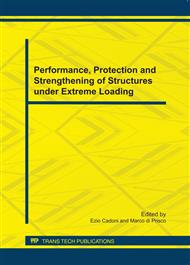[1]
B.M. Luccioni, R.D. Ambrosini, R.F. Danesi ,Failure of a reinforced concrete building under blast loads". WIT Trans. Eng. Sci., 49(2006) 336-345.
Google Scholar
[2]
J.L. O'Daniel, T. Krauthammer, Assessment of numerical simulation capabilities for medium–structure interaction systems under explosive loads. Comp. Struct. 63(1997) 875–87.
DOI: 10.1016/s0045-7949(96)00409-9
Google Scholar
[3]
J.M.K. Chock, R.K. Kapania . Review of two methods for calculating explosive Air blast. The Shock and Vibration Digest. 33(2001): 91-102.
DOI: 10.1177/058310240103300201
Google Scholar
[4]
M. Bangash, Impact and Explosion. Analysis and Design, Spon Press, Oxford, 1993.
Google Scholar
[5]
UFC 3-340-02: Structures to Resist the Effects of Accidental Explosions, Dept. of the Army, the NAVY and the Air Force, Washington, DC, USA, (2008)
Google Scholar
[6]
AASTP-1: Manual of NATO Safety Principles For the Storage of Military Ammunition and Explosives, NATO Int. Staff – Defense Invest. Div., (2006)
Google Scholar
[7]
S.M. Liang, J.S. Wang, H. Chen, Numerical study of spherical blast-wave propagation and reflection, Shock Waves, 12(2002) 59-68.
DOI: 10.1007/s00193-002-0142-5
Google Scholar
[8]
O. Igra, G. Hu, J. Falcovitz, W. Heilig, Blast wave reflection from wedges, J. Fluids Eng, 125(2003) 510-519.
DOI: 10.1115/1.1567310
Google Scholar
[9]
W.A. Keenan, J.E. Tancreto, Blast Environment From Fully and Partially Vented Explosions in Cubicles. Technical Report R828. Dept. Army Picatinny Arsenal, 1975.
Google Scholar
[10]
E.D. Esparza, W.E. Baker, G.A. Oldham, Blast Pressures Inside and Outside Suppressive Structures. Edgewood Arsenal Contractor Report. EM-CR-76042. (1975)
DOI: 10.21236/ada025504
Google Scholar
[11]
Z. Savir, I. Edri, D.Z. Yankelevsky, V.R. Feldgun, Y.S. Karinski, Blast Pressure Distribution on Interior Walls Due to a Partially Confined Explosion, Int. Workshop Struct. Response to Impact and Blast. Haifa, Israel, 2009.
DOI: 10.1260/2041-4196.2.1.1
Google Scholar
[12]
I. Edri, Z. Savir, V.R. Feldgun, YS. Karinski , DZ. Yankelevsky, On Blast Pressure Analysis Due to a Partially Confined Explosion: I. Experimental Studies, Int. J. Prot. Struct., 2(2011) 1-20
DOI: 10.1260/2041-4196.2.1.1
Google Scholar


